What will you do if your gear, clothes or shelter has a blowout? A lot of guys I know wouldn’t know how to repair their equipment 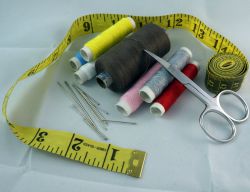 if need be. I was fortunate that I grew up around a grandmother who was a professional seamstress. I was able to watch, learn and help her as she sewed and made repairs for people in her small community. Of course, back then folks would buy a pattern for clothes and then either sew it themselves or have someone else sew it for them. Sewing dates back to the beginning of mankind and the need to produce clothing and shelter to provide protection from the climate and weather.
if need be. I was fortunate that I grew up around a grandmother who was a professional seamstress. I was able to watch, learn and help her as she sewed and made repairs for people in her small community. Of course, back then folks would buy a pattern for clothes and then either sew it themselves or have someone else sew it for them. Sewing dates back to the beginning of mankind and the need to produce clothing and shelter to provide protection from the climate and weather.
By Chuck Savage, a contributing author
My History of Sewing
Animal skins were sewn using an awl or needle made of sharp bones or sticks. Some Native Americans split the yucca plant and used the sharp tip to sew with. Porcupine quills were used and served to add color and decoration to sewing projects pre-dating bead work.
When I was younger, it wasn’t uncommon to see people sewing on new clothes or repair projects often but now it is a rarity. I have 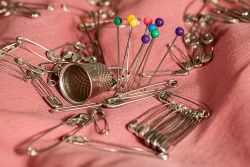 found that I now live in a disposable society. When something breaks or comes undone, you just throw it away and buy a new one. People often will not even return faulty goods because it’s just too much of a hassle. Reality will be in a SHTF world that you will have a hard time replacing needed items that come apart on you. For a period of time, stores will probably close and ordering online will be a distant memory. Learning to repair, fix and create items will be at a premium. It would be a great way to barter for the things you might need.
found that I now live in a disposable society. When something breaks or comes undone, you just throw it away and buy a new one. People often will not even return faulty goods because it’s just too much of a hassle. Reality will be in a SHTF world that you will have a hard time replacing needed items that come apart on you. For a period of time, stores will probably close and ordering online will be a distant memory. Learning to repair, fix and create items will be at a premium. It would be a great way to barter for the things you might need.
I have become known by my grand kids as “the fixer”. If it gets broken, they get it to me for repairs. This is a skill that I would recommend to everyone. If you don’t know how, learn to sew! The importance of learning to sew crossed my mind as I found a hole in the bottom of my EDC bag the other day. The hole was in a corner of the compartment that holds my pistol. The hole was all the way through the bag so I had to do something about it and soon.
Related article: Basic Needle and Thread Skills for Emergency Repairs
At first I looked up the return policy with the maker of the bag and found that returning it wasn’t an option. The rest of the bag was  in great shape so I went to my sewing kit and got to work. I used an upholstery needle and upholstery thread to make the repair. After stitching it up, I covered the area with Shoe Goo. If you aren’t familiar with Shoe Goo, you need to be. Shoe Goo will fix so many things. I rate it right up there with duct tape and 550 cord. My EDC is now back in service and better than ever. I have had to make field repairs on clothes, tents and tarps in the past. Having a good sewing repair kit is so valuable and should be in everyone’s B.O.B.
in great shape so I went to my sewing kit and got to work. I used an upholstery needle and upholstery thread to make the repair. After stitching it up, I covered the area with Shoe Goo. If you aren’t familiar with Shoe Goo, you need to be. Shoe Goo will fix so many things. I rate it right up there with duct tape and 550 cord. My EDC is now back in service and better than ever. I have had to make field repairs on clothes, tents and tarps in the past. Having a good sewing repair kit is so valuable and should be in everyone’s B.O.B.
For canvas and clothes repair, I also keep some iron on patches in the kit. I know you will probably wonder how that will do any good without the iron. For those who don’t remember, before electric irons, there were irons made of cast iron that you would heat up in the fire. If you can’t find one of these, use your cast iron skillet to iron the patch in place. Another use for your sewing skill is one I hope you never have to use but that is to sew up a wound. I would only do that if the benefits outweighed the risk of infection and done as sanitary as possible. I have carried sutures for years in my wilderness first aid kit but have never had to use them. I would do it as a last resort. There are many stitches to be learned but I will mention a few of the most important ones to master. With these techniques, you can fix most of the things you may need to repair.
Survival Sewing Kit
First let me suggest what you may need in a field sewing kit: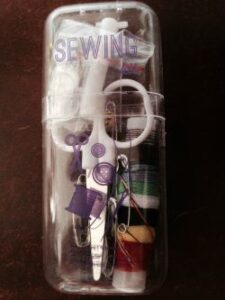
1. Thread-polyester, colors black, brown, khaki and white. Also a spool of black upholstery thread.
2. Needles- get an assortment to include an upholstery needle (bent)
3. Needle threading tools. For those of us with older eyes.
4. Thimble that fits your finger. My fingers are generally too fat for these
5. Pair of nipper scissors
6. Iron on patches- you can even get these in camo patterns
7. Assorted buttons
8. Assorted safety pins
I keep all of this in a small plastic box or you can use a small zippered bag. You just need something that will protect the contents and store well. There are small sewing kits that you can purchase that will work in a pinch. It works well in a bug out bag. The only problem is you will run out of thread before long and it is missing the iron on patches. Now that you have the basics, let’s look at some useful stitches to know.
Basic Sewing
You need to learn three basic stitches which include the overhand, blanket and straight stitch. The overhand stitch is a basic 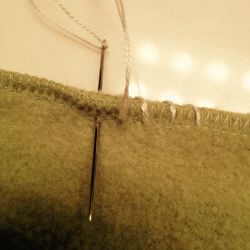 stitching that some call a whip stitch. This is used for joining two pieces of material together and can be used for hemming pants. First you anchor one end of your thread at the starting point. Then you pass the threaded needle through both pieces of fabric creating a small loop. Try to pass the needle through the fabric at regular intervals to look neat.
stitching that some call a whip stitch. This is used for joining two pieces of material together and can be used for hemming pants. First you anchor one end of your thread at the starting point. Then you pass the threaded needle through both pieces of fabric creating a small loop. Try to pass the needle through the fabric at regular intervals to look neat.
The spacing will give you a stronger or more loose bond depending on how many stitches per inch you sew. The next stitch is the blanket stitch which helps to reinforce the edge of your fabric such as a blanket. This will protect the edge and help keep it from fraying. It is similar to the overhand stitch but you connect each thread by passing the needle and thread through each loop.
The straight stitch runs in a straight line and can be used to hem pants or a dress or curtains. The needle and thread pass through 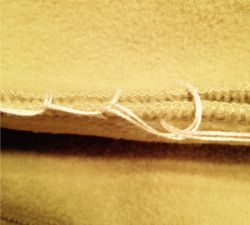 the fabric in a straight line, in and out, in and out. To end all of my stitches, I tie a square knot in the thread after passing the needle and thread through the fabric giving myself two ends. I have also used my sewing skills to make leather bags, pants, moccasins and shirts that could come in handy someday. Sewing leather is harder and requires special needles and artificial or real sinew. The needle is curved with a triangle shaped pointed tip to pass through the leather easier. You can also use a threaded Awl that sews like a hand sewing machine.
the fabric in a straight line, in and out, in and out. To end all of my stitches, I tie a square knot in the thread after passing the needle and thread through the fabric giving myself two ends. I have also used my sewing skills to make leather bags, pants, moccasins and shirts that could come in handy someday. Sewing leather is harder and requires special needles and artificial or real sinew. The needle is curved with a triangle shaped pointed tip to pass through the leather easier. You can also use a threaded Awl that sews like a hand sewing machine.
Not only is sewing useful for repairs, you may even enjoy it. Sewing is relaxing and will 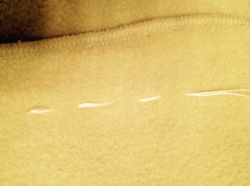 give you a real sense of accomplishment in a time when people are quick to discard things. Sew What? Sew most anything that needs repaired or made out of fabrics of any kind. Basically, if you can pass a needle and thread through it, it can be sewn. And oh, by the way this isn’t just for the girls and ladies. I have my own sewing machine and I’m not afraid to use it!
give you a real sense of accomplishment in a time when people are quick to discard things. Sew What? Sew most anything that needs repaired or made out of fabrics of any kind. Basically, if you can pass a needle and thread through it, it can be sewn. And oh, by the way this isn’t just for the girls and ladies. I have my own sewing machine and I’m not afraid to use it!

13 comments
Two thumbs up for Shoe Goo. I also stock Goop. I volunteer at a Thrift Store Donation area. When damaged items come through, the store doesn’t have the time to fix things, I usually will take them home for repairs. I limit myself to outdoor gear and clothing mostly, but the amount of stuff that people get rid of because they are too lazy to fix it is staggering. Good for me and my friends.
My sewing supplies are growing constantly too. Good thoughts Chuck.
yeh, I’ve been called a “so and so” a few times, myself.
it would be nice if thimbles for man sized fingers were easier to find. I sometimes grip the needle with a pair of long nosed pliers, when I have to push through heavy layers of fabric.
I’m also interested in learning sewing skills. No so much for clothing, but for gear repair (replacing zippers in duffel bags for example, especialy if curved in shape for example). Many have concluded that pant zippers really should be replaced with buttons, as they are easier to fix in the field. I thought the old military clothing was cheapened through lack of zippers – now I know better.
These seem skills can also be transferred into leather work. I sewed a leather luggage tab into a small case for a SOG Cross Cut micro tool case – much tougher than the original plastic case and the leather can be used for other tasks. I am thinking a metal tab can be sewed to this leather as a needle pusher that irishdutchuncle mentions above. I keep a sewing bobbin of G.I. trip wire on the key ring – makes extremely strong sewing repairs.
I appreciate the post.
it might be easier to use a couple copper rivets, to attach your metal piece…
sail makers use a “palm”, I think it’s called. it’s like a fingerless glove, with a metal piece, set in a pocket, around the base of the index finger. let’s see, I have a bunch of leather work gloves, with worn out fingers…
I was going to make some tool pouches, maybe I’ll try to make one for myself.
Thanks for the tips. That would be a good use for worn out gloves, I may have a couple with torn out fingers too. I can convert to a sailers palm – never thought of that.
I’ve made knife / tool pouches in the past using nylon belt / sling materials. I put the knife – tool against the material, fold over once to determine its length. Cut, then melt edges with a BIC to melt them together. I then staple the corners and a few along the edge – easy. If you want a belt loop, leave extra material at top and fold again (now an ‘S’ shape) and you are good.
One cheap tool pouch option using those beat out gloves – cut off the fingers, and two belt slots in the palm and you have a DIY tool holster
I’ve used coins to pull needles through material. A pair of pennies / nickels pinched over the implement will usually do the the trick.
Thanks for all of the great tips and comments. It’s good to know that I’m not weird or some girly man when it comes to sewing. LOL!
Girly is, as Girly Does… ? (mis-quoting Mrs. Gump)
survivalists may be unusual, but Odd isn’t the same as Queer.
I also learned to sew as a child, has come in handy many times. I use my multi-tool pliers (since I always carry them anyway) in lieu of a thimbles. I carry my BOB sewing kit in a pill bottle to keep it dry with several extra needles (think trade items), artificial sinew and heavy, multi-strand waxed thread. Also, a few feet of 100-miles-an-hour tape are wrapped around the pill bottle for clothing and gear patches; they can be sewn on, both sides if needed. This also strengthens the pill bottle considerably. I prefer wooden toggles to buttons because they are easier to make in the field (and less likely to break), 550 cord (another always-carried item) to secure them, and lastly because I find button holes hard to sew by hand! Since I also carry a few tea candles (also in a pill bottle), I can use wax instead of Shoe Goo, though it isn’t as good or as durable, but a lot less messy if spilled in a pack! If the general public doesn’t think you’re a little odd, then maybe you’re doing something wrong! Good Luck!
I also grew up with a grandmother who taught me how to sew. Some people laughed but I’ve used that skill more times than I can count
There are a bunch of good and CHEAP military surplus sewing kits out there. Definitely worth a look.
I have also been stocking up on strong thread. Most of the cheap stuff out there is not worth bringing home. Good reminder about shoe goo.
Another good reason to learn how to use a needle is to stitch up a wound. I was a biker in my early years and I stitched up a lot of wounds. Glad I left that life behind, just found out that most of my fellow bikers are dead now. Good choice, I think. Stay prepared my friends.
I know I’m months behind, but there’s a fairly new thimble out by Clover that comes in larger sizes and it’s got a silicone rubber ‘skirt’ so it’s more comfortable to wear. You can get it online at https://www.kenssewingcenter.com/clover-protect-and-grip-thimble-large-p-30214.html?utm_campaign=googleshopping&utm_medium=product_search&utm_source=googleshopping or Amazon, and it’s also being carried by stores like JoAnn’s and Michael’s.